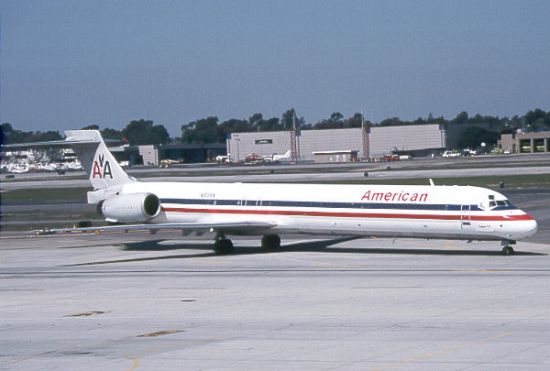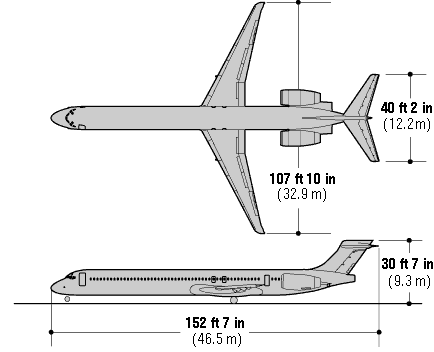|
||||||||||
|
|
||||||||||
|
||||||||||
|
|
||||||||||
 - -
|
|

|
McDonnell Douglas (now Boeing) MD-90 Medium-Range Jetliner |
|
DESCRIPTION:
The MD-90 became the third generation of the Douglas twin-jet family, following the highly successful DC-9 and MD-80. The MD-90 was originally envisioned as a high-tech alternative to the earlier designs featuring very fuel efficient engines known as propfans. However, the drop in oil prices of the 1980s resulted in weak interest in these new technology engines, so McDonnell Douglas abandoned them in favor of more conventional turbofans. Otherwise, the MD-90 is largely similar to the MD-80 it replaced, using the same basic fuselage, wing, and flight deck. However, the flight deck was updated with an improved electronic flight instrument system and other avionics plus new environmental control systems, hydraulic systems, and passenger comfort features. In addition, the new V2500 turbofan engines offered much improved fuel efficiency and noise emissions. Only one major version of the MD-90 entered production, the standard Series 30. A handful of MD-90-30 derivatives were also built in small numbers including the extended range MD-90-30ER, MD-90-30IGW increased gross weight model, and the MD-90-30T manufactured in China. Smaller Series 10 and lengthened Series 50 variants were also proposed but not developed. Although interest in the MD-90 family was strong, the fate of the design was sealed when McDonnell Douglas was purchased by Boeing. Since the MD-90 competed directly with Boeing's 737, the production line was closed. As a result, the MD-90 is a rather rare sight at world airports since only 116 were built beween 1995 and 2000. A total of 109 remained in airline service as of 2009.
Last modified 11 April 2011
|
|
| HISTORY: | |
| First Flight | 22 February 1993 |
|
Service Entry
|
1 April 1995 (with Delta Air Lines)
|
| CREW: |
two flight crew: pilot, co-pilot
|
| PASSENGERS: |
153 in two classes, 172 in one class
|
|
ESTIMATED COST:
|
unknown
|
| AIRFOIL SECTIONS: | |
| Wing Root | DSMA-433A/-434A |
|
Wing Tip
|
DSMA-435A/-436A
|
| DIMENSIONS: | |
| Length | 152.50 ft (46.52 m) |
| Wingspan | 107.67 ft (32.87 m) |
| Height | 30.92 ft (9.42 m) |
| Wing Area | 1,209 ft² (112.3 m²) |
|
Canard Area
|
not applicable
|
| WEIGHTS: | |
| Empty | 86,590 lb (39,275 kg) |
| Normal Takeoff | unknown |
| Max Takeoff |
(MD-90-30) 156,000 lb (70,760 kg) (MD-90-50) 172,000 lb (78,245 kg) |
| Fuel Capacity |
internal: (MD-90-30) 5,840 gal (22,100 L) (MD-90-50) 7,620 gal (28,845 L) external: not applicable |
|
Max Payload
|
unknown
|
| PROPULSION: | |
| Powerplant |
(MD-90-30) two International Aero V2525-D5 turbofans (MD-90-50) two International Aero V2528-D5 turbofans |
| Thrust |
(MD-90-30) 50,000 lb (222.42 kN) (MD-90-50) 56,000 lb (249.11 kN) |
| PERFORMANCE: | |
| Max Level Speed |
at altitude: unknown at sea level: unknown cruise speed: 505 mph (810 km/h) at 35,000 ft (10,680 m), Mach 0.76 |
| Initial Climb Rate | unknown |
| Service Ceiling | unknown |
| Range |
(MD-90-30) 2,080 nm (3,860 km) (MD-90-50) 2,785 nm (5,160 km) |
| g-Limits |
unknown
|
| KNOWN VARIANTS: | |
| DC-9 Super 90 | Original design study that ultimately led to the MD-90 family |
| MD-90 Series 30 | Initial production model intended to replace the MD-83; 111 built |
| MD-90-30ER | Extended range model based on the Series 30 but with additional fuel tanks in the forward cargo hold and strengthened wing structure for operation at higher gross weights; 2 built |
| MD-90-30IGW | Increased Gross Weight variant of the Series 30 with strengthened wing structure and landing gear; 1 built |
| MD-90-30T Trunkliner | Proposed 147-passenger model based on the MD-90-30 with dual main landing gear for operation from rough airfields, 40 initially to have been built by Shanghai Aviation Industrial Corporation for Chinese operators; 2 built |
| MD-90 Series 10 | Proposed shortened fuselage model to carry reduced passenger loads of 111 to 116, intended to replace the MD-87; cancelled |
| MD-90 Series 40 | Proposed stretched model for up to 181 passengers; cancelled |
| MD-90-40EC | Proposed Series 40 variant with increased payload and fuel capacity for European operators; cancelled |
| MD-90 Series 50 | Proposed extended range model with additional fuel capacity and increased gross takeoff weight; cancelled |
| MD-90-55 |
Similar to the Series 50 but with a revised cabin layout making room for up to 187 passengers; cancelled
|
| KNOWN OPERATORS: |
Air Aruba AMC Aviation American Airlines Astraeus Airlines Blue1 China Eastern Airlines China Northern Airlines China Southern Airlines Cool1 Airlines Delta Air Lines Eva Airways Hello Airlines Japan Air System Lion Air Pacific Airlines SAS Scandinavian Airlines Saudi Arabian Airlines Uni Air |
|
3-VIEW SCHEMATIC:

|
|
SOURCES:
|
|


|
Aircraft | Design | Ask Us | Shop | Search |

|
|
| About Us | Contact Us | Copyright © 1997-2023 | |||
|
|
|||